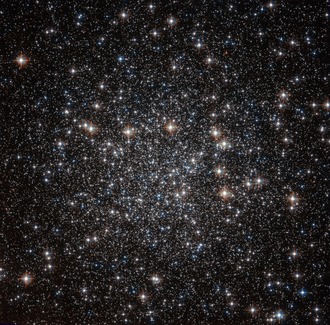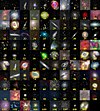NGC 4833
|
Globular cluster data from NGC 4833 |
|
|---|---|

|
|
| Image taken by NGC 4833 of the Hubble Space Telescope | |
| AladinLite | |
| Constellation | Fly |
|
Position equinox : J2000.0 , epoch : J2000.0 |
|
| Right ascension | 12 h 59 m 34.9 s |
| declination | -70 ° 52 ′ 28 ″ |
| Appearance | |
| Concentration class | VIII |
| Brightness (visual) | 8.4 mag |
| Angular expansion | 14 ' |
|
Color excess E (BV) (redness) |
0.32 ± 0.03 |
| Physical data | |
| Affiliation | Milky Way |
| Redshift | (671 ± 4) · 10 −6 |
| Radial velocity | (+201.1 ± 1.3) km / s |
| distance | approx. 19000 ly (approx. 5700 pc ) |
| Concentration lg (r t / r c ) | 1.25 |
| Metallicity [Fe / H] | −1.83 ± 0.14 |
| history | |
| discovery | NL de Lacaille |
| Discovery date | 1751 |
| Catalog names | |
| NGC 4833 • C 1256-706 • GCl 21 • Mel 115 • Dun 164 • GC 3325 • Lacaille I.4, Bennett 56, Caldwell 105, h 3444 | |
NGC 4833 is the name of a globular cluster in the constellation Fly in the southern sky . It has an angular diameter of 13.5 arc minutes and is about 19,000 light years from the sun .
The object was discovered in 1751 by NL de Lacaille .
Web links
- astronews.com: Picture of the day August 2, 2016
Individual evidence
- ↑ NASA / IPAC EXTRAGALACTIC DATABASE
- ↑ a b c SEDS : NGC 4833
- ↑ a b Melbourne et al .: "CCD Photometry of the Globular Cluster NGC 4833 and Extinction Near the Galactic Plane"; in: The Astronomical Journal, Vol. 120, Issue 6, pp. 3127ff. bibcode : 2000AJ .... 120.3127M
- ↑ SIMBAD database
- ↑ Seligman
